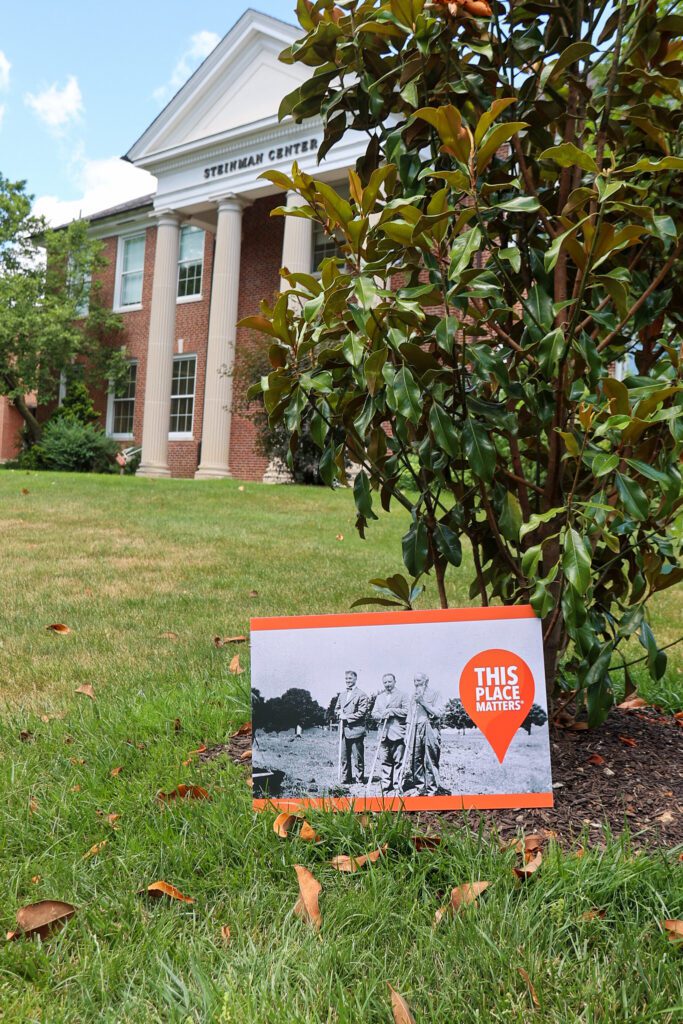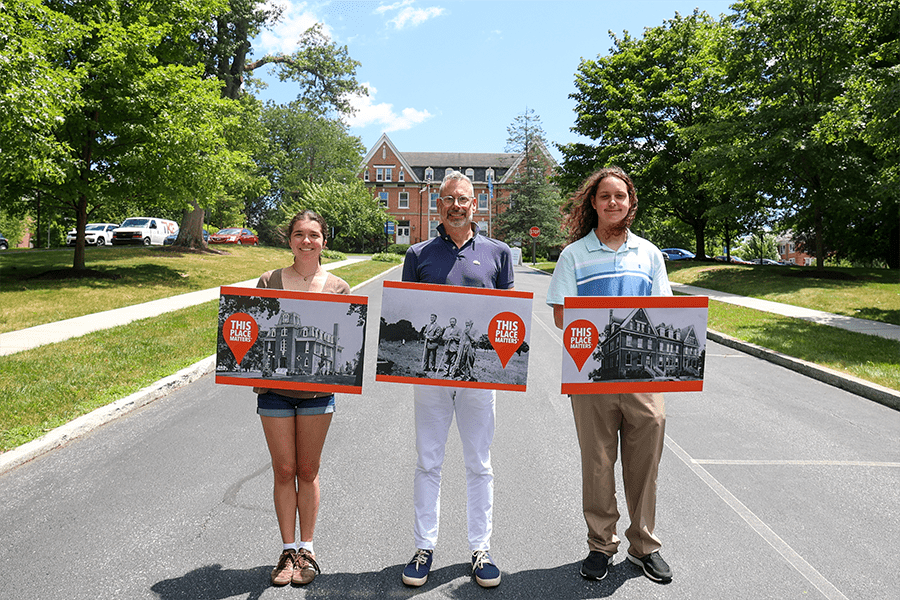As Elizabethtown College begins celebrating its 125th anniversary this fall, Ava Barton ’27 and Shawn Gipe ’27 spent their summer on campus working alongside faculty mentor and Director of Prestigious Scholarships and Public Heritage Studies Jean-Paul Benowitz to create a resource highlighting the architectural and biographical history of the College as part of the Summer Creative Arts and Research Program (SCARP).
Their research led to the creation of a Historic Walking Tour of Elizabethtown College, along with posters showcasing the history of each campus building, which will be displayed inside the buildings this fall. The group’s research was also part of The National Historic Preservation Trust’s, “This Place Matters” campaign, which helps promote public awareness of the importance of maintaining, preserving, and recognizing the historical and cultural significance of locations and properties across the country.
Title of Research
Elizabethtown College 125th Anniversary National Historic Preservation Trust This Place Matters Campaign & Campus Historic Building Survey Based on the National Parks Service Historic American Building Survey
Student Researchers
Ava Barton ’27 (Business Administration, Political Science & Journalism major)
Shawn Gipe ’27 (Legal Studies major)
Faculty Mentor
Jean-Paul Benowitz, Director of Prestigious Scholarships and Public Heritage Studies
What are you researching?
Barton and Gipe: We are researching every building on campus by interpreting the architectural style, writing biographical sketches of the architects, documenting the construction firms involved, and detailing the purpose and usage of each building in the past, present, and future. Additionally, we are writing short biographies of the individuals for whom the buildings were named after. Our research involves public records, primary historical sources, and historical images, supplemented by fieldwork using the National Collegiate Honors Council’s Signature Program, “The City As Text.” This project is inspired by Charles E. Peterson (1906-2004), who pioneered the discipline of historic preservation. Under Peterson’s supervision, the National Parks Service began documenting America’s historic buildings in 1933 as part of the Roosevelt administration’s efforts. This led to the creation of the Historic American Buildings Survey in 1934, which was formally established by Congress through the Historic Sites Act of 1935. Our work is also influenced by the “This Place Matters” national campaign by the National Historic Preservation Trust, which encourages people to celebrate places meaningful to them and their communities. As part of our project, we are creating “This Place Matters” social media posts for each building and inviting alumni and retired faculty to share their memories. Each building report will be linked to an ArcGIS map, plotting all campus buildings online. We are also designing posters for each building, featuring historical and contemporary images along with summaries of our findings. These posters will be displayed in the vestibules of campus buildings throughout the 2024-25 academic year as part of the 125th anniversary celebrations.
Why did you choose this topic?
Barton and Gipe: We chose this topic to produce the ArcGIS story map, the posters, and the print and social media content to contribute to the events and programming related to the 2024-25 celebrations of the 125th Anniversary of Elizabethtown College. By discussing the people for whom the buildings are named on campus, we are telling the history of the College.
What was the most interesting aspect of this research?
Barton: Through understanding the history of Elizabethtown College, I am gaining a deeper appreciation for the campus and the dedication of those who founded and developed the College. Each biographical essay I am writing requires a slightly different research method using primary and secondary resources about the history of the College. I am constantly problem-solving and putting together the puzzle pieces to assemble a complete picture of the College’s history.
Gipe: The aspect I find most interesting about this research has been learning about the founding of Elizabethtown College, the hard and costly work put into its creation, and those who put great effort into ensuring the College came to fruition. Understanding just how hard the founders worked is giving me a greater appreciation for what Etown is today and for the founders who created the College. When learning about the tireless and routine work many had to put in every day for several years, using money out of their own pockets in many cases to further Etown’s progression and sometimes even sacrificing their health for the sake of the College. It truly shows how the ideals behind Elizabethtown College are more than just words.
What are you hoping to accomplish through this research?
Barton and Gipe: We want to honor the memory of the people who devoted their lives to the service of Elizabethtown College, to create a forum where alumni and retired faculty can share their stories and contribute to the narrative of the history of the college, we want to provide context for our campus community and inspire people to continue bringing leadership and service to the College.
Talk about working with your mentor. How have they helped you throughout this experience?
Barton: Through regular meetings and an ongoing conversation about our research findings and the results of our fieldwork, Professor Benowitz has been extremely supportive throughout the research process. Using knowledge from his previous research on Elizabethtown College and local history, he provides context and helps us through roadblocks in our research by suggesting other sources. He is doing an excellent job of being an active mentor while giving us agency over developing processes for compiling information. I have learned so much, not only about Etown’s history but also about the practice of research.
Gipe: Professor Benowitz, our mentor, has helped me throughout this experience by providing direction for our research and supplying us with books and online sources to reference for our research. These resources have been incredibly helpful for finding information on important figures in the college’s history and the buildings for whom they have been named. Additionally, we have attended meetings with Professor Benowitz to give reports on our progress and discuss our research. These meetings have helped guide how we should proceed with our research and have the additional benefit of learning from Professor Benowitz, which adds important context to our research.
Hear from the faculty mentor — Jean-Paul Benowitz
“It has been wonderful to observe the enthusiasm Ava and Shawn have developed for understanding and sharing biographical narratives of the people who played significant roles in the history of the College and how they have been immortalized in the built landscape of our campus. It is also fascinating to note how Ava and Shawn have been personally inspired by writing about historical figures related to the history of Etown as they discern their calling and vocation. Ava and Shawn recognize the important contribution they are making to the history of the College by researching, writing, and sharing their scholarship.”

